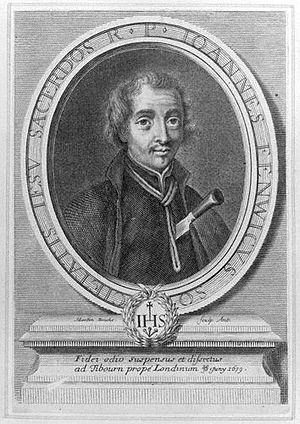John Fenwick (Jesuit) facts for kids
Quick facts for kids BlessedJohn Fenwick SJ |
|
|---|---|

Engraving of John Fenwick by Martin Bouche, 1683, National Portrait Gallery
|
|
| Martyr | |
| Born | c.1628 Durham, England |
| Died | 20 June 1679 (aged 50–51) Tyburn, London, England |
| Honored in | Roman Catholic Church |
| Beatified | 15 December 1929, Rome by Pope Pius XI |
| Feast | 20 June |
John Fenwick (born Caldwell, 1628–20 June 1679) was an English Jesuit priest. He was put to death during a time when people believed in a made-up plot called the Popish Plot. The Roman Catholic Church honors him as a martyr, and he was declared "Blessed" in 1929 by Pope Pius XI.
Contents
Early Life and Becoming a Priest
John Fenwick was born in County Durham, England, around 1628. His parents were Protestant. However, John decided to become a Roman Catholic. Because of this, his parents no longer supported him.
He went to a school called the College of St. Omer. After that, he studied to become a priest in Liège. On September 28, 1660, he joined the Society of Jesus, also known as the Jesuits. This is a religious group within the Catholic Church.
After finishing his studies, he became a priest. From 1662, he worked for several years as an agent for the College of St. Omer. In 1676, he became a fully recognized Jesuit priest and was sent to England.
The Popish Plot and His Arrest
In London, John Fenwick worked for St. Omer's College and also as a missionary priest. In 1678, a man named Titus Oates made up a story about a "Popish Plot." He claimed that Catholics were planning to kill King Charles II and take over the government.
Based on Oates's false information, John Fenwick was called to appear before the King's Privy Council. He was then sent to Newgate Prison, a famous jail in London. He was put in chains, which caused him great pain. His letters were taken, but they showed nothing wrong. Fenwick pointed out that out of over a thousand letters, none proved he was involved in any plot.
First Trial and Second Trial
John Fenwick was first tried for high treason, which means plotting against the King. He was tried with another Jesuit, William Ireland. Titus Oates claimed he heard them planning to kill the King. Fenwick and Ireland said this was not true. There wasn't enough proof, so Fenwick was sent back to prison.
However, during this time, many people in England were very worried about Catholics. So, it was decided that Fenwick would be tried again. On June 13, 1679, he appeared at the Old Bailey court in London. He was tried with four other Jesuit priests: John Gavan, William Harcourt, Thomas Whitebread, and Anthony Turner.
Titus Oates and two other people, William Bedloe and Stephen Dugdale, were the main witnesses against them. Even though the Jesuits strongly defended themselves, the jury found them guilty. Fenwick protested, saying, "All the evidence comes but to this: there is but saying and swearing." He meant that the accusers were just saying things without real proof.
His Execution
On June 20, 1679, John Fenwick and the four other Jesuits were put to death at Tyburn, a place in London where executions happened. The King knew they were innocent but felt he couldn't pardon them because of the political situation. He did, however, order that they be allowed to die quickly, sparing them from further harsh treatment.
A large crowd watched the execution. They listened quietly as each man declared his innocence. This showed that public opinion was starting to turn against the idea of the Popish Plot. John Fenwick's body was buried in the churchyard of St. Giles-in-the-Fields.

